Hyundai Nexo 2019 Owner's Manual
Manufacturer: HYUNDAI, Model Year: 2019, Model line: Nexo, Model: Hyundai Nexo 2019Pages: 560, PDF Size: 24.2 MB
Page 501 of 560
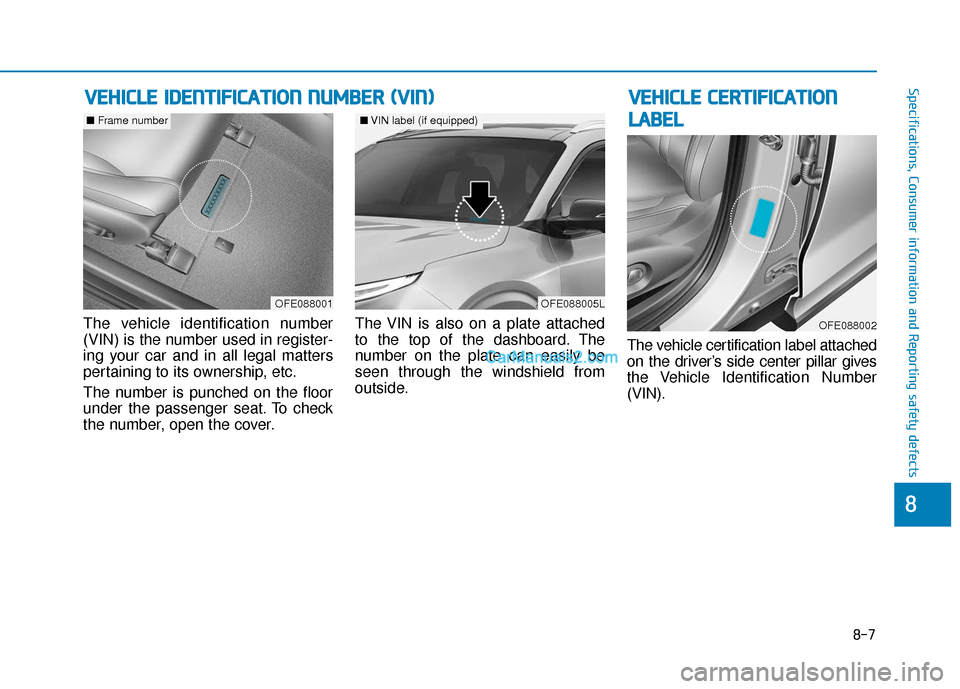
8-7
88
Specifications, Consumer information and Reporting safety defects
The vehicle identification number
(VIN) is the number used in register-
ing your car and in all legal matters
pertaining to its ownership, etc.
The number is punched on the floor
under the passenger seat. To check
the number, open the cover.The VIN is also on a plate attached
to the top of the dashboard. The
number on the plate can easily be
seen through the windshield from
outside.
The vehicle certification label attached
on the driver’s side center pillar gives
the Vehicle Identification Number
(VIN).
V V
E
EH
H I
IC
C L
LE
E
I
ID
D E
EN
N T
TI
IF
F I
IC
C A
A T
TI
IO
O N
N
N
N U
U M
M B
BE
ER
R
(
( V
V I
IN
N )
)
OFE088005L
■ VIN label (if equipped)
OFE088001
■ Frame number
OFE088002
V
VE
EH
H I
IC
C L
LE
E
C
C E
E R
R T
TI
IF
F I
IC
C A
A T
TI
IO
O N
N
L
L A
A B
BE
EL
L
Page 502 of 560
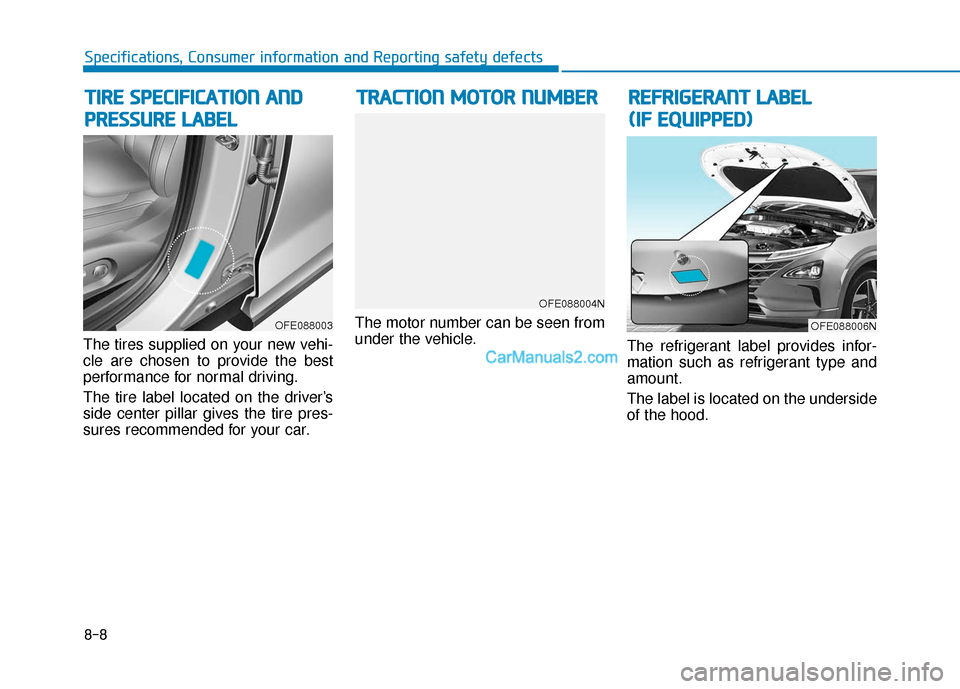
8-8
Specifications, Consumer information and Reporting safety defects
The tires supplied on your new vehi-
cle are chosen to provide the best
performance for normal driving.
The tire label located on the driver’s
side center pillar gives the tire pres-
sures recommended for your car. The motor number can be seen from
under the vehicle.
The refrigerant label provides infor-
mation such as refrigerant type and
amount.
The label is located on the underside
of the hood.
T TR
R A
A C
CT
T I
IO
O N
N
M
M O
OT
TO
O R
R
N
N U
U M
M B
BE
ER
R R
RE
EF
FR
R I
IG
G E
ER
R A
A N
N T
T
L
L A
A B
BE
EL
L
(
( I
IF
F
E
E Q
Q U
UI
IP
P P
PE
ED
D )
)
T
T
I
IR
R E
E
S
S P
P E
EC
CI
IF
F I
IC
C A
A T
TI
IO
O N
N
A
A N
N D
D
P
P R
R E
ES
SS
SU
U R
RE
E
L
L A
A B
BE
EL
L
OFE088003OFE088006N
OFE088004N
Page 503 of 560
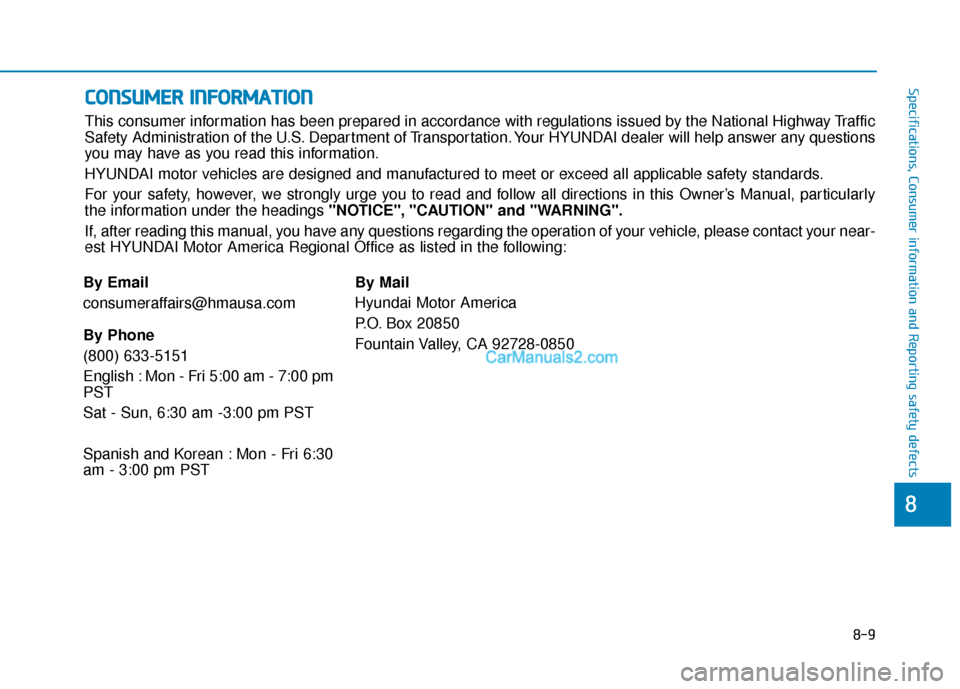
8-9
88
Specifications, Consumer information and Reporting safety defectsC
CO
O N
NS
SU
U M
M E
ER
R
I
IN
N F
FO
O R
RM
M A
AT
TI
IO
O N
N
This consumer information has been prepared in accordance with regulations issued by the National Highway Traffic
Safety Administration of the U.S. Department of Transportation. Your HYUNDAI dealer will help answer any questions
you may have as you read this information.
HYUNDAI motor vehicles are designed and manufactured to meet or exceed all applicable safety standards.
For your safety, however, we strongly urge you to read and follow all directions in this Owner’s Manual, particularly
the information under the headings "NOTICE", "CAUTION" and "WARNING".
If, after reading this manual, you have any questions regarding the operation of your vehicle, please contact your near-
est HYUNDAI Motor America Regional Office as listed in the following:
By Email
[email protected]
By Phone
(800) 633-5151
English : Mon - Fri 5:00 am - 7:00 pm
PST
Sat - Sun, 6:30 am -3:00 pm PST
Spanish and Korean : Mon - Fri 6:30
am - 3:00 pm PST By Mail
Hyundai Motor America
P.O. Box 20850
Fountain Valley, CA 92728-0850
Page 504 of 560
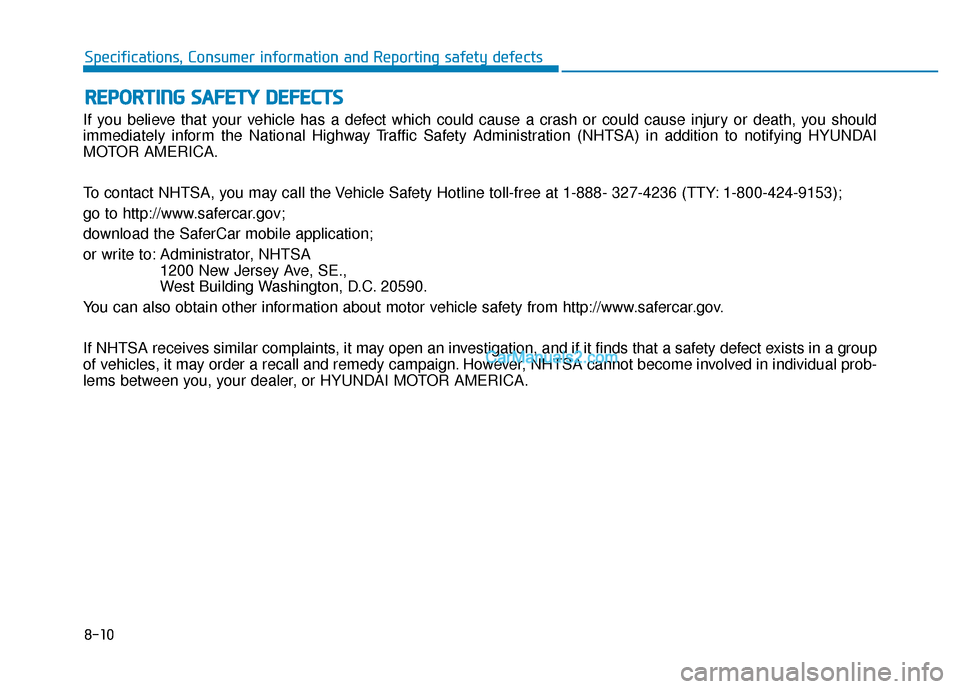
8-10
Specifications, Consumer information and Reporting safety defects
If you believe that your vehicle has a defect which could cause a crash or could cause injury or death, you should
immediately inform the National Highway Traffic Safety Administration (NHTSA) in addition to notifying HYUNDAI
MOTOR AMERICA.
To contact NHTSA, you may call the Vehicle Safety Hotline toll-free at 1-888- 327-4236 (TTY: 1-800-424-9153);
go to http://www.safercar.gov;
download the SaferCar mobile application;
or write to: Administrator, NHTSA 1200 New Jersey Ave, SE.,
West Building Washington, D.C. 20590.
You can also obtain other information about motor vehicle safety from http://www.safercar.gov.
If NHTSA receives similar complaints, it may open an investigation, and if it finds that a safety defect exists in a group
of vehicles, it may order a recall and remedy campaign. However, NHTSA cannot become involved in individual prob-
lems between you, your dealer, or HYUNDAI MOTOR AMERICA.
R R E
EP
P O
O R
RT
TI
IN
N G
G
S
S A
A F
FE
E T
T Y
Y
D
D E
EF
FE
E C
CT
T S
S
Page 505 of 560
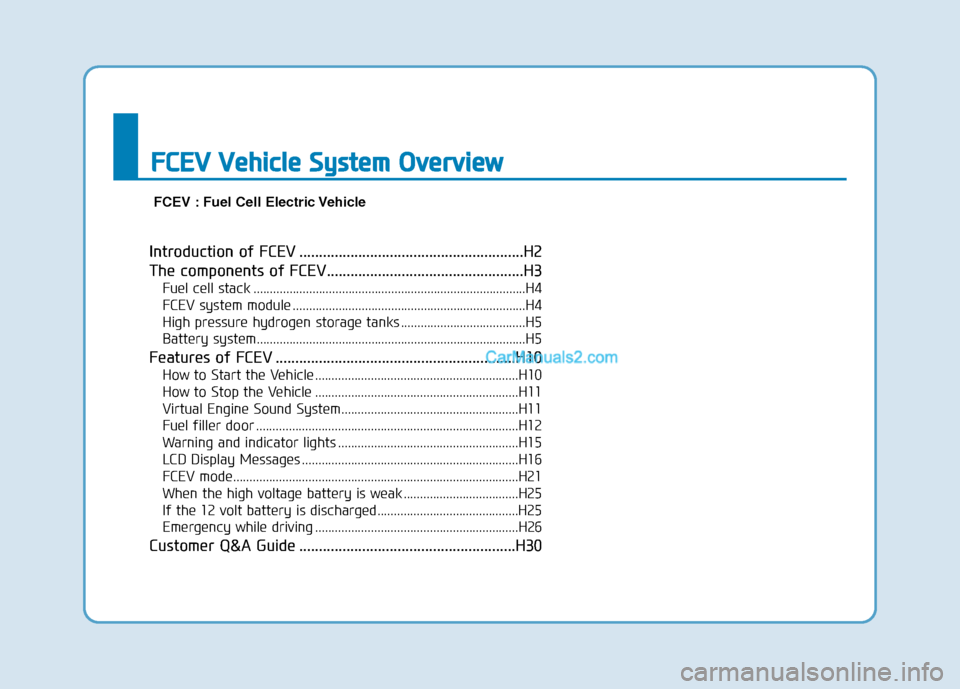
Introduction of FCEV .........................................................H2
The components of FCEV..................................................H3
Fuel cell stack ........................................................................\
...........H4
FCEV system module .......................................................................H\
4
High pressure hydrogen storage tanks ......................................H5
Battery system........................................................................\
..........H5
Features of FCEV .............................................................H10
How to Start the Vehicle ..............................................................H10
How to Stop the Vehicle ..............................................................H11
Virtual Engine Sound System......................................................H11
Fuel filler door ........................................................................\
........H12
Warning and indicator lights .......................................................H15
LCD Display Messages ..................................................................H16
FCEV mode........................................................................\
...............H21
When the high voltage battery is weak ...................................H25
If the 12 volt battery is discharged...........................................H25
Emergency while driving ..............................................................H26
Customer Q&A Guide .......................................................H30
F FC
C E
E V
V
V
V e
eh
h i
ic
c l
le
e
S
S y
ys
st
te
e m
m
O
O v
ve
e r
rv
v i
ie
e w
w
FCEV : Fuel Cell Electric Vehicle
Page 506 of 560
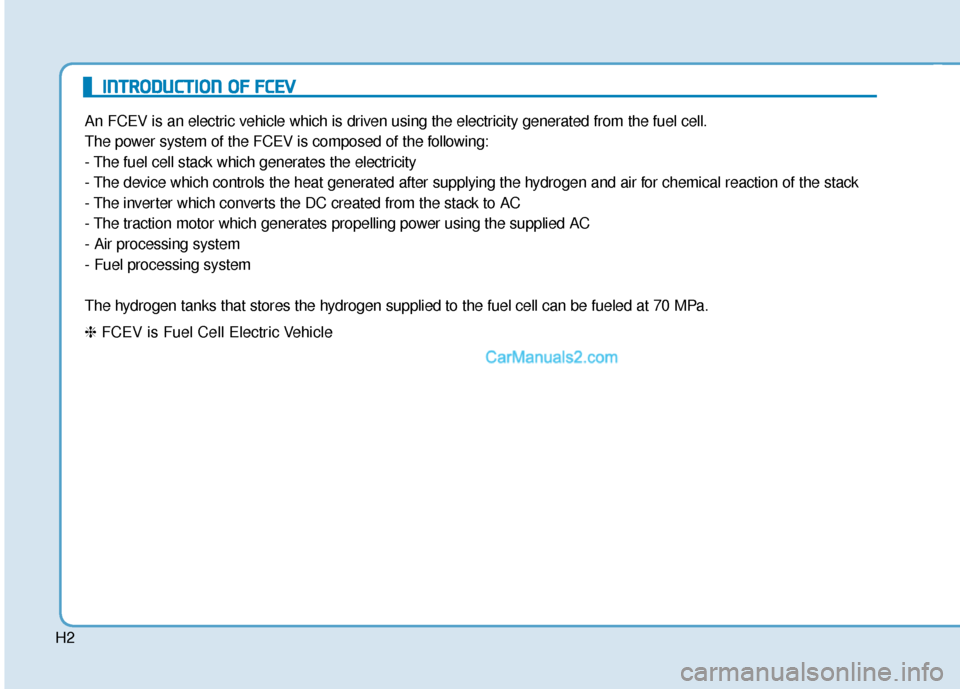
H2
An FCEV is an electric vehicle which is driven using the electricity generated from the fuel cell.
The power system of the FCEV is composed of the following:
- The fuel cell stack which generates the electricity
- The device which controls the heat generated after supplying the hydrogen and air for chemical reaction of the stack
- The inverter which converts the DC created from the stack to AC
- The traction motor which generates propelling power using the supplied AC
- Air processing system
- Fuel processing system
The hydrogen tanks that stores the hydrogen supplied to the fuel cell can be fueled at 70 MPa.
❈FCEV is Fuel Cell Electric Vehicle
I IN
N T
TR
R O
O D
DU
U C
CT
T I
IO
O N
N
O
O F
F
F
F C
C E
E V
V
Page 507 of 560
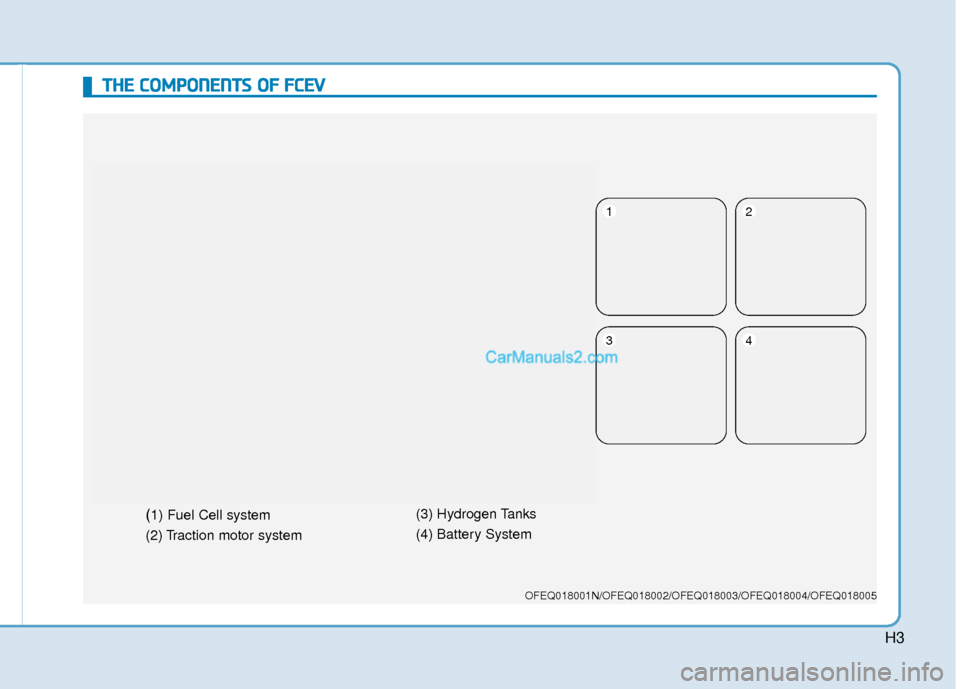
H3
T
TH
H E
E
C
C O
O M
M P
PO
O N
NE
EN
N T
TS
S
O
O F
F
F
F C
C E
E V
V
OFEQ018001N/OFEQ018002/OFEQ018003/OFEQ018004/OFEQ018005
(1) Fuel Cell system
(2) Traction motor system (3) Hydrogen Tanks
(4) Battery System
12
34
Page 508 of 560
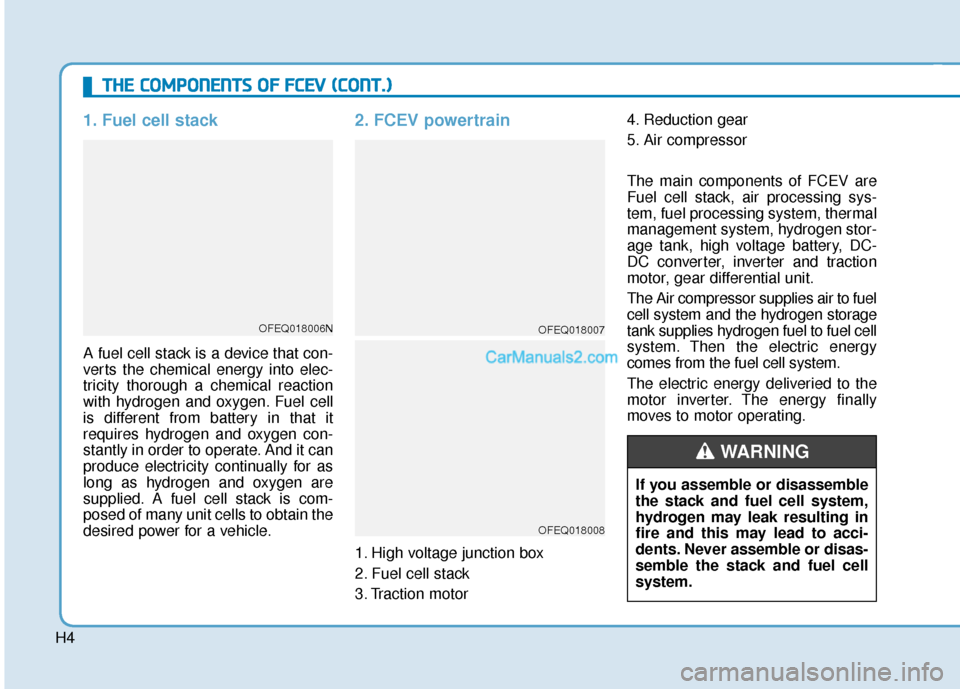
H4
1. Fuel cell stack
A fuel cell stack is a device that con-
verts the chemical energy into elec-
tricity thorough a chemical reaction
with hydrogen and oxygen. Fuel cell
is different from battery in that it
requires hydrogen and oxygen con-
stantly in order to operate. And it can
produce electricity continually for as
long as hydrogen and oxygen are
supplied. A fuel cell stack is com-
posed of many unit cells to obtain the
desired power for a vehicle.
2. FCEV powertrain
1. High voltage junction box
2. Fuel cell stack
3. Traction motor4. Reduction gear
5. Air compressor
The main components of FCEV are
Fuel cell stack, air processing sys-
tem, fuel processing system, thermal
management system, hydrogen stor-
age tank, high voltage battery, DC-
DC converter, inverter and traction
motor, gear differential unit.
The Air compressor supplies air to fuel
cell system and the hydrogen storage
tank supplies hydrogen fuel to fuel cell
system. Then the electric energy
comes from the fuel cell system.
The electric energy deliveried to the
motor inverter. The energy finally
moves to motor operating.
T T
H
H E
E
C
C O
O M
M P
PO
O N
NE
EN
N T
TS
S
O
O F
F
F
F C
C E
E V
V
(
( C
C O
O N
NT
T.
.)
)
OFEQ018006NOFEQ018007
OFEQ018008
If you assemble or disassemble
the stack and fuel cell system,
hydrogen may leak resulting in
fire and this may lead to acci-
dents. Never assemble or disas-
semble the stack and fuel cell
system.
WARNING
Page 509 of 560
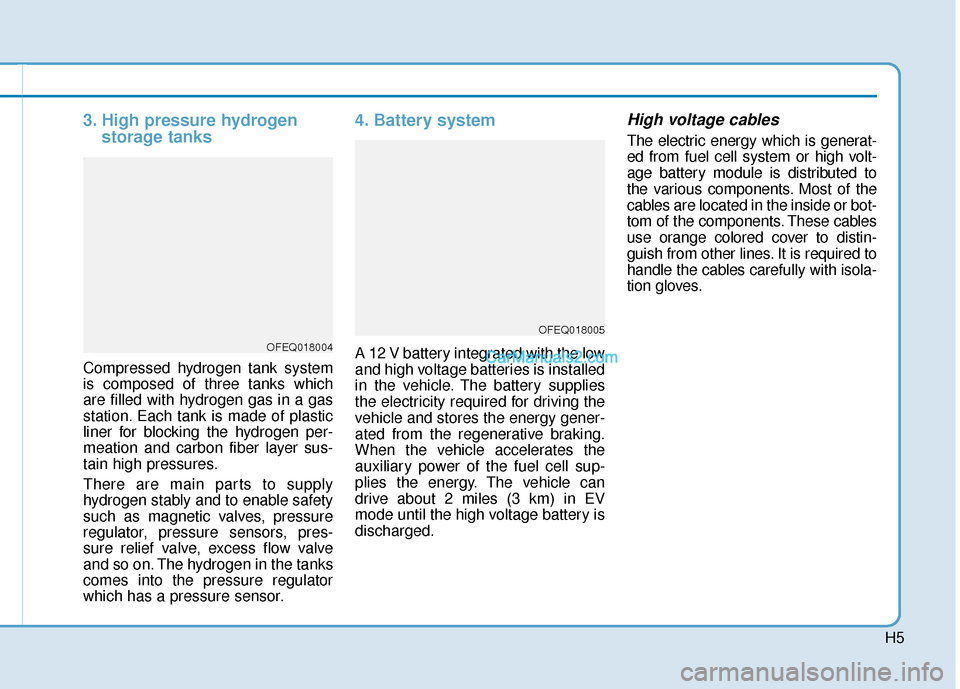
H5
3. High pressure hydrogenstorage tanks
Compressed hydrogen tank system
is composed of three tanks which
are filled with hydrogen gas in a gas
station. Each tank is made of plastic
liner for blocking the hydrogen per-
meation and carbon fiber layer sus-
tain high pressures.
There are main parts to supply
hydrogen stably and to enable safety
such as magnetic valves, pressure
regulator, pressure sensors, pres-
sure relief valve, excess flow valve
and so on. The hydrogen in the tanks
comes into the pressure regulator
which has a pressure sensor.
4. Battery system
A 12 V battery integrated with the low
and high voltage batteries is installed
in the vehicle. The battery supplies
the electricity required for driving the
vehicle and stores the energy gener-
ated from the regenerative braking.
When the vehicle accelerates the
auxiliary power of the fuel cell sup-
plies the energy. The vehicle can
drive about 2 miles (3 km) in EV
mode until the high voltage battery is
discharged.
High voltage cables
The electric energy which is generat-
ed from fuel cell system or high volt-
age battery module is distributed to
the various components. Most of the
cables are located in the inside or bot-
tom of the components. These cables
use orange colored cover to distin-
guish from other lines. It is required to
handle the cables carefully with isola-
tion gloves.
OFEQ018004
OFEQ018005
Page 510 of 560
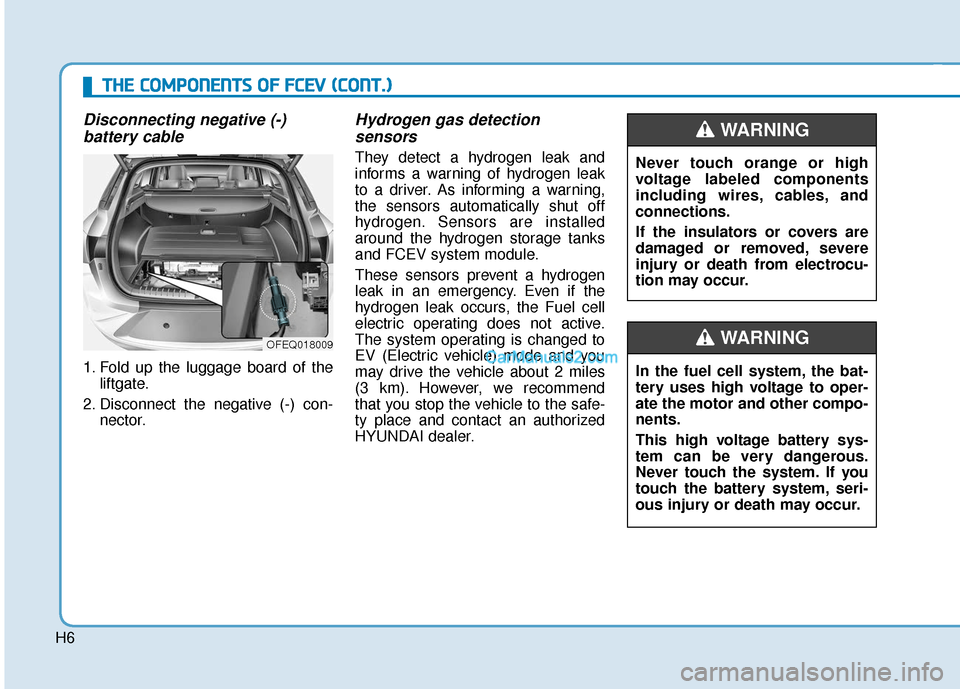
H6
Disconnecting negative (-) battery cable
1. Fold up the luggage board of the
liftgate.
2. Disconnect the negative (-) con- nector.
Hydrogen gas detection sensors
They detect a hydrogen leak and
informs a warning of hydrogen leak
to a driver. As informing a warning,
the sensors automatically shut off
hydrogen. Sensors are installed
around the hydrogen storage tanks
and FCEV system module.
These sensors prevent a hydrogen
leak in an emergency. Even if the
hydrogen leak occurs, the Fuel cell
electric operating does not active.
The system operating is changed to
EV (Electric vehicle) mode and you
may drive the vehicle about 2 miles
(3 km). However, we recommend
that you stop the vehicle to the safe-
ty place and contact an authorized
HYUNDAI dealer.
OFEQ018009
T
T H
H E
E
C
C O
O M
M P
PO
O N
NE
EN
N T
TS
S
O
O F
F
F
F C
C E
E V
V
(
( C
C O
O N
NT
T.
.)
)
Never touch orange or high
voltage labeled components
including wires, cables, and
connections.
If the insulators or covers are
damaged or removed, severe
injury or death from electrocu-
tion may occur.
WARNING
In the fuel cell system, the bat-
tery uses high voltage to oper-
ate the motor and other compo-
nents.
This high voltage battery sys-
tem can be very dangerous.
Never touch the system. If you
touch the battery system, seri-
ous injury or death may occur.
WARNING